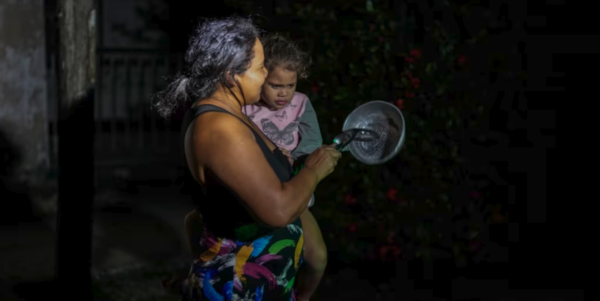Pots and Pans Protests in Cuba, Risky but Effective

By Francisco Acevedo
HAVANA TIMES – The situation in Cuba had already been quite precarious for months, but the passage of hurricanes Oscar and Rafael worsened it even more, and protests grew, especially due to the lack of electricity for several days. Rafael hit the western part of Cuba last Wednesday with winds up to 186 kilometers per hour (115 mph) and rainfall of up to 195 millimeters (7.5 inches).
In the municipality of Encrucijada, in the central province of Villa Clara, where no cyclone passed, people were without power for two days and took to the streets on Thursday, November 7th. They didn’t let the “leader” speak, who tried to give an explanation in front of the Municipal People’s Power Assembly (town hall). As usual, the local leader attempted to keep asking for patience and endurance, but the crowd shouted, “You won’t silence us!”
It was later confirmed that the regime’s repressive forces detained several protesters due to the lack of effective solutions from the Government, at least eight according to various independent organizations. They were reportedly taken out of the police station handcuffed and through a garage to prevent them from being seen, while their families remained at the entrance demanding their release.
Hours after the protest, the Villa Clara Electric Company announced the restoration of service in several circuits of the municipality, including the sectors of Jutiero, Vizcaya, and Comunidad la Sierra, although they cut off internet access to prevent people from broadcasting live. Additionally, State Security agents provoked the protesters, pushing them and taking their phones to prevent filming, as well as threatening them during the protest.
Detentions were also reported in the town of Manicaragua, also in Villa Clara, after similar incidents, including roadblocks and damage to state facilities.
The Attorney General’s Office confirmed on Saturday that several people in the provinces of Havana, Mayabeque (west), and Ciego de Avila (center) were charged after protesting the lack of electricity, on the third day of the national blackout after Hurricane Rafael, accused of assault, public disorder, and damage.
According to the Attorney General’s Office, all are in provisional detention, but this “public transparency” is nothing more than an attempt to intimidate Cubans.
According to the Cuban Conflict Observatory, in October, Cuba registered a total of 863 individual or collective public protests, mainly in those days when the National Electric System completely collapsed, but not only at that time.
Everything suggests that tourism, one of the country’s main sources of income (more than 10 percent of Cuba’s economy), will decline in the coming months, as the sector is already suffering. For example, in recent days, tourists have had to rely on private transporters because state-run companies suspended their activities.
If, before the blackout, it was projected that only 2.7 million tourists would visit the island this year, a 16 percent decrease compared to the previous projection, it is very likely that this number will not be reached.
Moreover, if the government officially acknowledges that more than one million Cubans —more than 10 percent of the population— have emigrated abroad in the past two years, it is highly probable that this figure will rise with the new wave of difficulties.
In an attempt to distract the population, the authorities of Santiago de Cuba decided to carry out this weekend “a collective intervention in neighborhoods with a strong popular presence in Santiago and other municipalities of the province,” according to their social media. Another smokescreen while the disaster continues, and the wounds left by Hurricane Oscar are still open.
There was no video on social media as in the case of Villa Clara, but in neighborhoods in the capital like Nuevo Vedado, Guanabacoa, and Centro Habana, there were also pots and pans protests after several days without electricity. By the way, in the areas where people went out into the streets, they restored power —another indication that protests work and that the repressors fear that it will become widespread.
Many areas in the western part of the country, including the capital, continue without electricity, more than 96 hours after the blackout on Wednesday, just three weeks after the nationwide power outage.
In the midst of the total blackout in mid-October, President Miguel Diaz-Canel threatened citizens who protested the energy disaster. In a video of a meeting that was disseminated, he stated that his regime would not accept or allow “anyone to provoke vandalistic acts, much less disrupt the peace of our people.”
Given all that has happened here, any other country in the world would have publicly lynched them. Let’s remember that in Chile, for raising the subway fare by three cents, several cars were burned, and the same thing happened in France or any other country with a brave population.
The moment has to come, and it is proven that they cannot stop it once Cuban citizens get serious.
It is unclear whether these protests over the blackouts will reach the level of the street demonstrations that shook the island in July 2021, when more than 700 people were arrested and sentenced to long prison terms, but it cannot be ruled out.
Now that Donald Trump has won the election in the United States, what’s coming is likely another set of measures to further close off supply to the dictatorship, and that will worsen the situation across the country.
The situation of exhaustion is now unsustainable, and if a larger outbreak of protests or even a national strike has not occurred, it is due to the fierce repression unleashed when things return to “normal.” But next time, there may be no turning back.
